Fluorescent probe for simultaneously detecting aluminum ions and zinc ions and preparation and application of fluorescent probe
A technology of fluorescent probes and zinc ions, which is applied in the field of fluorescent probes for metal ion detection, can solve the problems of rare bifunctional probes, achieve good selectivity, anti-interference ability, and easy purification
- Summary
- Abstract
- Description
- Claims
- Application Information
AI Technical Summary
Problems solved by technology
Method used
Image
Examples
preparation example Construction
[0032]A method for preparing a fluorescent probe for simultaneously detecting aluminum ions and zinc ions, including the following steps:
[0033](1) Add 1-(4-bromophenyl)-1,2,2-tristyrene, p-formylphenylboronic acid, tetrakis(triphenylphosphine)palladium, and anhydrous potassium carbonate to the round bottom reaction flask , Wherein the molar ratio of 1-(4-bromophenyl)-1,2,2-tristyrene, p-formylbenzeneboronic acid, tetrakis(triphenylphosphine)palladium and anhydrous potassium carbonate is 1:1.2:0.05 :5, use ethylene glycol dimethyl ether and deionized water as solvents, where the volume ratio of ethylene glycol dimethyl ether and water is 1:5, under nitrogen atmosphere, reflux and stir for 12 hours, and purified to obtain (II) Compound:
[0034]
[0035](2) Dissolve compound (II) in absolute ethanol, add o-aminophenol, the molar ratio of compound (II) to o-aminophenol is 1:2, under nitrogen atmosphere, reflux and stir for 6h to obtain (I) The compound shown.
[0036]A method for preparing the ...
Embodiment 1
[0042]Example 1: Synthesis of probe
[0043](1) First, compound (II) is synthesized by Suzuki reaction.
[0044]The specific steps are as follows: Combine 1-(4-bromophenyl)-1,2,2-tristyrene (1mmol; 411mg), p-formylphenylboronic acid (1.2mmol; 180mg), tetrakis(triphenylphosphine) palladium (0.05mmol; 58mg), anhydrous potassium carbonate (5mmol; 691mg) were added to a 100mL two-necked reaction flask, with ethylene glycol dimethyl ether (15mL) and deionized water (3mL) as solvents, under nitrogen atmosphere, reflux Stir for 12h. After the reaction, it was cooled to room temperature, the reaction solution was extracted with dichloromethane, and dried with anhydrous magnesium sulfate, the solvent was removed by a rotary evaporator under reduced pressure, and finally petroleum ether: dichloromethane (15:1, v:v) was used as The eluent was separated by silica gel column chromatography to obtain a light green product with a yield of 58%.
[0045]1H NMR (600MHz, Chloroform-d) δ 10.03 (s, 1H), 7.91 (d,...
Embodiment 2
[0049]Example 2: Fluorescence detection of aluminum ion and zinc ion by probe in aqueous solution
[0050]Prepare Al with a concentration of 10-2M separately3+,Fe3+,Co2+,Mg2+,Ni2+,Ag+,Cu2+,Pb2+,Mn2+,Zn2+,K+,Cd2+,Hg2+,Cr3+,Ca2+,Na+Aqueous solution.
[0051]The acetone solution of the probe prepared in Example 1 was prepared with a concentration of 2.5 mM. The prepared various metal ion solutions (10-2M, 10μL) was added to the probe (2.5mM, 100μL) and diluted with deionized water to a total volume of 10ml. A steady-state fluorescence spectrophotometer was used to measure the influence of the addition of different ions on the fluorescence intensity. Such asfigure 1 with2As shown, only the addition of aluminum ions and zinc ions can cause the fluorescence intensity to change: adding aluminum ions, the fluorescence intensity at 492nm is significantly increased, showing cyan fluorescence; adding zinc ions, the fluorescence intensity at 592nm is significantly increased, showing orange fluorescen...
PUM
 Login to View More
Login to View More Abstract
Description
Claims
Application Information
 Login to View More
Login to View More - R&D Engineer
- R&D Manager
- IP Professional
- Industry Leading Data Capabilities
- Powerful AI technology
- Patent DNA Extraction
Browse by: Latest US Patents, China's latest patents, Technical Efficacy Thesaurus, Application Domain, Technology Topic, Popular Technical Reports.
© 2024 PatSnap. All rights reserved.Legal|Privacy policy|Modern Slavery Act Transparency Statement|Sitemap|About US| Contact US: help@patsnap.com










